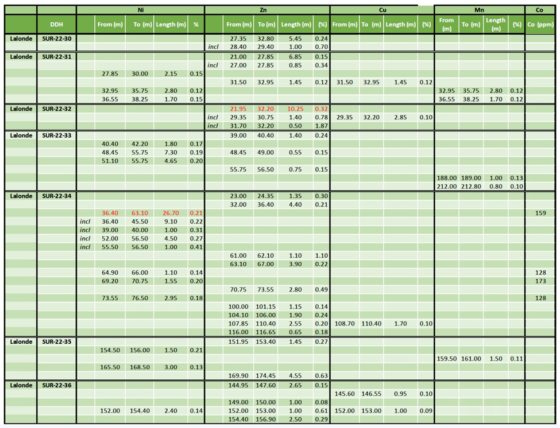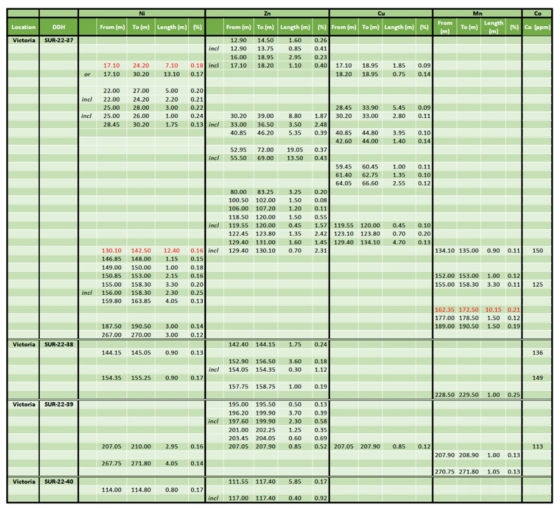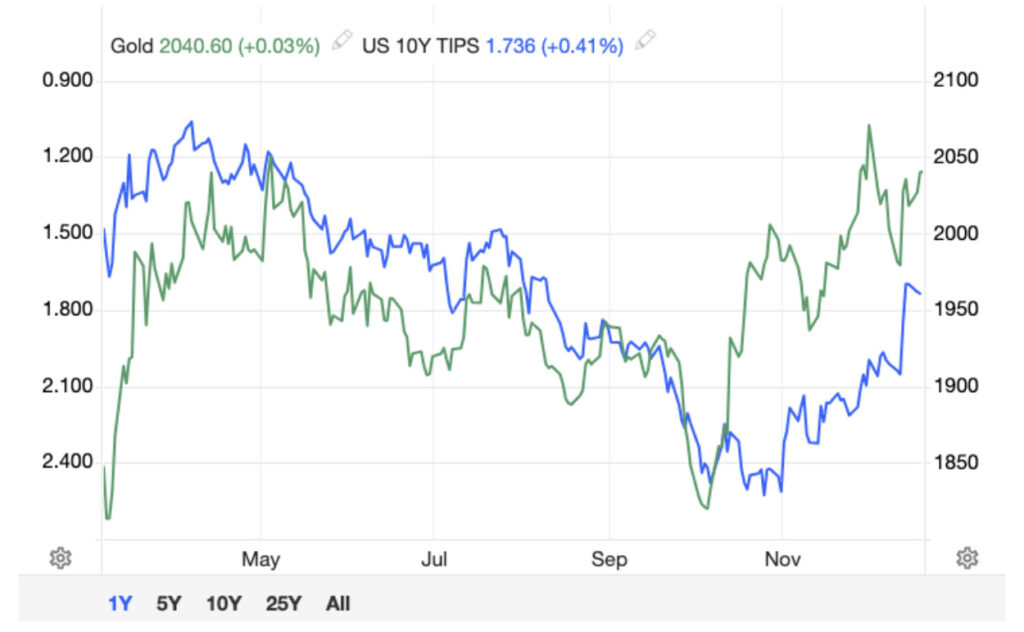Companies
Renforth’s polymetallic Surimeau Project has battery, critical and precious metals – Richard Mills
2023.02.17
The Surimeau mineral deposit in Quebec being developed by Renforth Resources (CSE:RFR, OTCQB:RFHRF, FSE:9RR) has until now been considered a…
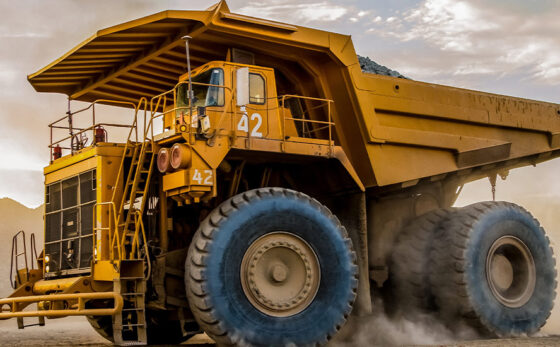
2023.02.17
The Surimeau mineral deposit in Quebec being developed by Renforth Resources (CSE:RFR, OTCQB:RFHRF, FSE:9RR) has until now been considered a battery and critical metals play, with nickel, copper and most recently, lithium, being the dominant metals.
A new geological interpretation suggests the 330-square-km property also contains precious metals, in particular gold and silver.
Surimeau
Renforth has been receiving assays from the December, 2022 drill program at its two main targets at Surimeau — Lalonde and Victoria.
Surimeau hosts several areas prospective for gold/silver and battery/ industrial metals (nickel, copper, zinc, lead, cobalt and lithium). It is located south of the Cadillac Break, a major regional gold structure.
The property occurs within a unique geological setting where two types of mineralization, formed from different geological processes, are “mashed together” in one distinct orebody. It is best described as an ultramafic nickel sulfide, juxtaposed with a copper-zinc volcanogenic massive sulfide (VMS).
The first type of mineralization, which contains nickel, cobalt and platinum group elements (PGEs), is associated with ultramafic rocks. The second type, VMS, was formed on or near the ocean floor during ancient underwater volcanic activity.
VMS deposits are sought after for mining because they usually contain a mix of base metals such as zinc, lead, copper, and sometimes precious metals. The minerals often form massive sulfide mounds or layers, making them relatively easy to extract.
Renforth has mainly focused on the polymetallic “battery metals” package of nickel, cobalt, copper, zinc, platinum and palladium that is present in at least six known areas of the property.
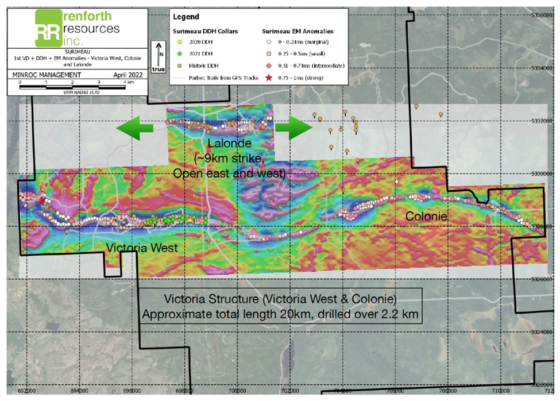
Last year, Renforth devoted only a few days to prospecting for lithium in a limited area; this work was focused only on the pegmatites mapped by Metals Tech Lithium, and noted by the Quebec government’s SIGEOM database in the southwest part of the property.
Renforth taking a closer look at lithium- and rare earths-bearing pegmatites
However, in addition to pegmatite sampling, Renforth has determined that the Decelles batholith, which forms the southern portion of Surimeau, is a fertile batholith and has an area of influence for pegmatite formation of 10 km. The company therefore considers most of the property prospective for pegmatites (pegmatites often form along the edges of batholiths); with pegmatites noted as far north as Victoria and Lalonde.
According to Renforth, only the area around the Rapid 7 road and south of the Victoria mineralization was prospected, with accessible pegmatites and granites visited and sampled. Sampling resulted in elevated lithium, cesium, rubidium and tantalum at various locations, generally within the sediments near to, or in contact with, pegmatites.
This could be interpreted as either a halo effect due to the mobility of various elements, or indicative of unseen lithium-bearing pegmatite.
All of the documented pegmatites were visited and sampled, though this work covers only a small percentage of the prospective ground; new pegmatites were also found and sampled.
Of all the grab samples, there was limited assaying for rare earth elements; Renforth has since concluded that any future work with respect to lithium should assay for rare earths.
Lithium assay values ranged from background up to 800 parts per million (a re-assay of a sample that originally assayed 410 ppm), for cesium from background up to 169 ppm, rubidium from background up to 1,170 ppm, and tantalum from background up to 149.5 ppm.
Drill results & interpretation
Renforth announced on Feb. 15 that gold has been intersected during drilling at Victoria — the first such instance of the precious metal within the 20-km-long mineralized system.
Also, Lalonde has been confirmed as a mineralized system with drill results similar to surface samples.
According to the company, Surimeau hosts two battery metals systems with open-pit potential.
A third band of mineralization was intersected at Victoria in the December drilling. This is interpreted as the northern mineralization splitting, as noted below.
“Our successful December drill program effectively confirmed two mineralized systems on this property. Surimeau is still relatively underexplored, both within the 29 km of surface battery metals mineralization, and outside of those two systems where we have a copper discovery in the NE part of the property, pegmatites in the southern part of the property, and the presence of lithium, to date in the [Pontiac Group] sediments, with a big question mark as to what that could mean,” Renforth’s President and CEO Nicole Brewster said in the Feb. 15 news release. She added:
“Our priority is the two battery metals mineralized zones, which start at surface and have only been shallowly explored to date. Located as we are with renewable electricity, road access in an established mining camp, contiguous to Canada’s largest open-pit gold mine in one of the best mining jurisdictions in the world, it is exciting to contemplate a potential open pit in the future with every cost advantage one could desire; we are working towards that vision.”
Electric vehicle sales top $1 trillion in wake-up call for carmakers
As it executes the first modern exploration at Surimeau, to define the extent of surface nickel sulfide, polymetallic mineralization over a ~29-km length, Renforth has begun developing a mineralization model.
Two trends of 250-500 meters thickness, run east-west across the central portion of the property, @ Lalonde and Victoria. These trends primarily consist of mafic and ultramafic flows intercalated with graphitic mudstones, albite shears and calc-silicate rocks. Exploration has confirmed strike lengths of 20 km and 9 km respectively.
Currently the two systems are interpreted as two arms of a fold, with the fold nose located off the property and to the east.
Lalonde
Renforth’s first drilling at Lalonde, in December 2022, delivered grades and widths that justify further exploration. They include hole SUR-22-34, which yielded 26.7m of 0.21% nickel (Ni) and 159 parts per million (ppm) cobalt (Co), as well as 1m of 0.41% Ni. This hole also returned 52.75m of 0.45 g/t silver (Ag). A lengthy intercept, albeit at a relatively low grade, that Renforth says is indicative of a silver-endowed zone, including 1.1m of 1.10% zinc (Zn). It may also signal a VMS system; Renforth is working with an expert to vector in on the mineralization.
In all, seven holes for a total of 1,973.6 meters, were drilled at Lalonde over a strike length of about 430 meters. The holes were drilled near to, or under, previously stripped and samples areas, as well as into geophysical anomalies, Renforth states.
Each hole drilled at Lalonde intersected the mineralized zone, in many instances cutting through both the northern and southern bands of mineralization, that have been previously seen on surface during prospecting and trenching completed in 2022.
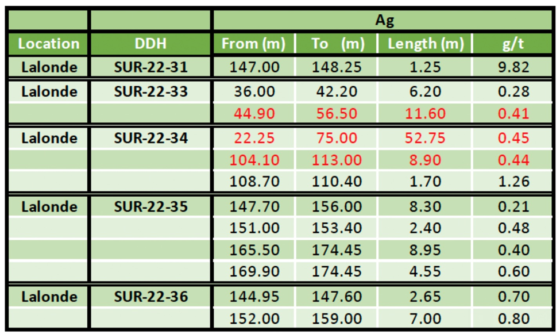
Victoria
At Victoria, hole SUR-22-77 reported 13.10m of 0.17% Ni, followed by 8.8m of 1.87% Zn. Further down, the hole also featured a large amount of copper relative to other holes at Victoria, including 7m of 0.13% Cu.
Gold, like silver, is an indicator mineral of a VMS system, and Renforth was lucky enough to find it while drilling into a previously untested anomaly. Hole SUR-22-37 intersected 2.5m of 0.55 g/t Au.
Four holes for a total of 1,113 meters were drilled at Victoria in December, out of 6,741m drilled to date over a strike length of 2.2 km. According to Renforth, the holes were designed to intersect two geophysical anomalies the company was previously unaware of, until high-resolution mag and EM survey interpretations were completed.
That led to theidentification of 18 discrete conductive anomalies within the first ~100m of depthmeasured by the survey, one of which was located in the central Victoria area within the main mineralized system. The other three holes were drilled to test for mineralization north of the main system, as prospecting and geophysics suggested there was a secondary horizon.
Each hole drilled at Victoria intersected the mineralized system. The three holes drilled to test for the northern band of mineralization were successful, however they also led Renforth to believe that the northern band has actually split to form two bands, making three horizons/bands.

“At Surimeau we are seeing mineralized systems with significant footprints; 20 and 9 kilometers are long distances. Currently we are seeing low grades, however, these grades are in the context of current and historic polymetallic mining operations, like Terrafame’s Talvivaara open pit heap leach operation in Finland, or Outokumpu in eastern Finland (as cited by Dr. Franklin, a consulting geologist),” said CEO Nicole Brewster.
One of the largest nickel mines in Finland, and Europe, Talvivaara has a billion tonnes of reserves grading 0.22% Ni, 0.13% Cu, 0.5% Zn and 0.2% Co, containing 2.2 million tonnes of nickel, 1.3 million tonnes of copper, 5 million tonnes of zinc and 0.2 million tonnes of cobalt. (Talvivaara Mining Company, 2010 via Wikipedia)
The mine, which has been in operation since 2008, is reportedly the most successful example of a bio-heap leach for nickel sulfides, with a resource grade of 0.26% Ni, 0.14% Cu, 0.02% Co and 0.54% Zn.
According to a report by Wood Mackenzie, Terrafame, the owner, was aiming to produce around 25kt Ni per annum by 2018. Since then, nickel production has increased to 30 kt/a Ni and 55 kt/a Zn. In June 2021, Terrafame reported that production had started to ramp up at its new battery chemicals plant, which was approved for development in 2018 at a cost of €240 million.
The Ootokumpu mineral district in Finland is known for several unconventional sulfide deposits with economic grades of copper, zinc, nickel, cobalt, silver and gold. About 50 million tonnes of ore averaging 2.8% Cu, 1% Zn and 0.2% Co, along with traces of Ni and Au, were mined from three deposits between 1913 and 1988. By 1930, Outokumpu had become a major producer of copper and an important exporter of copper ore.
“The fact that mines like those, large scale and low grade, north of the Artic Circle, can operate, gives us the motivation and validation we need to continue to define the extent of mineralization at Surimeau,” Brewster continued.
“We are also located next door to an open pit [Canadian Malartic Mine], that sets a precedent for what is possible, with road access and hydro-electric power on our uninhabited property. We have our work cut out for us, however, we see it as valid based on examples and our logistical cost advantages, as well as the macro situation for the various metals at Surimeau, especially nickel.”
Manganese primer
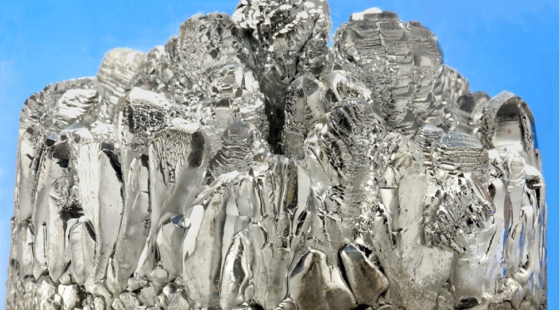
During this latest round of drilling, RFR noticed manganese at both Victoria and Lalonde. SUR-22-37, for example, cut 10.15m of 0.21% Mn. Renforth says it will review prior drilling to check for manganese.
For those unfamiliar with manganese, it is the most essential mineral in the production of steel. Both Canada and the United States have numerous and vast iron ore deposits, yet neither country produces manganese. You can’t produce steel without adding 10 to 20 pounds of Electrolytic Manganese Metal (EMM) per ton of iron.
According to the United Stated Geological Society (USGS) the US is 100% dependent on imported supplies of manganese. Manganese has no substitute in its many steel applications and has become a substitute for other more expensive metals in certain alloys.
The same circuits that make EMM make electrolytic manganese dioxide (EMD). EMD is a key ingredient in the production of lithium-ion, lithiated-ion, alkaline and new battery technology — a zinc/manganese battery is likely to become the replacement for the environmentally unfriendly lead/acid automotive batteries. This battery market is still, by far, the largest in the world and is not going to disappear, despite the increasing adoption of lithium battery-powered electric vehicles.
Since there are no mines producing manganese ore in the US or Canada, there are no domestic suppliers of EMM in North America.
The United States is the largest consumer of EMD worldwide. China controls 97% of the global trade in EMM.
Everyone knows that alakaline batteries have long been made out of zinc/manganese. Many are now starting to realize just how important manganese is to the electric vehicle and energy storage markets.
That’s because one of the most successful lithium-ion battery systems is a cathode combination of nickel, manganese and cobalt (NMC). NMC batteries are used in power tools and in vehicle power trains (they offer higher energy density and therefore greater range). NMC batteries are also preferred for electric vehicles because they are less combustible.
An NMC battery is one-third nickel, one-third manganese and one-third cobalt.
Manganese is also an ingredient in lithium manganese oxide (LMO) batteries. LMO batteries can deliver a lot of energy in a short period of time, making them ideal for power tools, medical devices and e-bikes.
Finally, magnesium is a promising candidate to replace lithium-ion batteries, whose limitations include relatively low energy density and the susceptibility for combustion, when punctured or exposed to high temperatures, but the new batteries need a better cathode material. Researchers at the Tokyo University of Science are studying ways to improve the performance of cathode materials based on magnesium-vanadium batteries. According to a news release, “Through future research and development, magnesium batteries could surpass lithium-ion batteries thanks to the former’s higher energy density.”
2023 drilling
Renforth is focusing the first-quarter, 2023 drill program on the never-before-explored-or-drilled western anomaly at Victoria. Initial prospecting in 2021 delivered surface mineralization in this area, which coincided with the subsequently flown mag/EM survey, and again delivered surface mineralization in confirmation prospecting in 2022.
The company has received its drill permit and has started 2023 field work. A crew is preparing the ground ahead of drilling anticipated to occur in March, following the annual PDAC conference.
Conclusion
“This thing is huge and it is mineralized. We have only seen glimpses of what the two systems truly are, but what we have seen is worth pursuing,” says Renforth’s President and CEO Nicole Brewster, in a recent note to shareholders regarding Surimeau.
The work to date certainly looks very promising. Renforth has released a geological interpretation of two trends, between 250 and 500 meters thickness, running east-west across the central portion of the property, @ Lalonde and Victoria. These trends primarily consist of mafic and ultramafic flows intercalated with graphitic mudstones, albite shears and calc-silicate rocks. Exploration has confirmed strike lengths of 20 km and 9 km respectively.
Renforth is drilling the structure and the structure keeps growing. Multiple bands of mineralization are being found in places the geological team expected they would. Within a few weeks drilling will resume 4 km to the west of the Victoria target.
Lalonde has also been confirmed as a mineralized system, with first drilling in December revealing grades and widths comparable to what was seen on surface.
For the first time, gold showed up in the Victoria system, and while it was low-grade, it was over a good interval. The most important thing to note about the gold discovery, is that gold is typically found in VMS deposits, sought after for mining because they usually contain base metals such as zinc, lead, copper, and sometimes precious metals. Renforth thinks it sees stringers in the drilling, which could indicate it is onto the VMS at Surimeau. Brewster says shareholders should bear in mind that about 20 km north of Victoria is Agnico-Eagle’s LaRonde, a gold-rich VMS mine that also produces a good amount of copper. VMS’s tend to occur in clusters, suggesting there are more in the area besides LaRonde.
Mineralization at Surimeau starts at surface, making the project a potential candidate for at least one open-pit mine, maybe more, along the current 29-km strike length. The property is contiguous to Canadian Malartic, one of Canada’s largest open-pit gold mines, measuring 4 km long and 400 meters deep. The mine’s developer, Osisko, proved the doubters wrong that low grade/ large tonnage can work, as long as operating costs are kept low. Could Surimeau be comparable to Malartic and other low-grade polymetallic mines, such as Outokumpu and Talvivaara in Finland? “That is our inspiration,” says Brewster.
I would add the following: Surimeau’s district-scale potential, along with its mineral composition, gives it a very unique flavor. The property is now prospective for battery, critical and precious metals. Not only does it host copper, nickel, cobalt and zinc in potentially large quantities, but also lithium, manganese, gold and silver.
While other battery chemistries including those with manganese are being explored, lithium-ion batteries are expected to be the dominant power source for electric vehicles and energy storage for many years to come. It was recently reported that global demand for lithium-ion batteries is expected to grow five-fold by 2030. In the United States, the demand is one magnitude higher, at 6X, and could translate to $55 billion by the end of the decade, Reuters said.
Currently very little lithium is mined in North America and so the United States (and Canada) is expected to rely on imports for supply, for the foreseeable future, even as billions of dollars are being channeled into new battery plants and electric-vehicle factories. Where are they going to source the metals?
Domestic sources of battery metals are crucial and Renforth potentially hosts a very large polymetallic system.
Renforth Resources
CSE:RFR, OTCQB:RFHRF, FSE:9RR
Cdn$0.035; 2023.02.16
Shares Outstanding 325m
Market cap Cdn$11.4m
RFR website
Richard (Rick) Mills
aheadoftheherd.com
subscribe to my free newsletter
Legal Notice / Disclaimer
Ahead of the Herd newsletter, aheadoftheherd.com, hereafter known as AOTH.
Please read the entire Disclaimer carefully before you use this website or read the newsletter. If you do not agree to all the AOTH/Richard Mills Disclaimer, do not access/read this website/newsletter/article, or any of its pages. By reading/using this AOTH/Richard Mills website/newsletter/article, and whether you actually read this Disclaimer, you are deemed to have accepted it.
Any AOTH/Richard Mills document is not, and should not be, construed as an offer to sell or the solicitation of an offer to purchase or subscribe for any investment.
AOTH/Richard Mills has based this document on information obtained from sources he believes to be reliable, but which has not been independently verified.
AOTH/Richard Mills makes no guarantee, representation or warranty and accepts no responsibility or liability as to its accuracy or completeness.
Expressions of opinion are those of AOTH/Richard Mills only and are subject to change without notice.
AOTH/Richard Mills assumes no warranty, liability or guarantee for the current relevance, correctness or completeness of any information provided within this Report and will not be held liable for the consequence of reliance upon any opinion or statement contained herein or any omission.
Furthermore, AOTH/Richard Mills assumes no liability for any direct or indirect loss or damage for lost profit, which you may incur as a result of the use and existence of the information provided within this AOTH/Richard Mills Report.
You agree that by reading AOTH/Richard Mills articles, you are acting at your OWN RISK. In no event should AOTH/Richard Mills liable for any direct or indirect trading losses caused by any information contained in AOTH/Richard Mills articles. Information in AOTH/Richard Mills articles is not an offer to sell or a solicitation of an offer to buy any security. AOTH/Richard Mills is not suggesting the transacting of any financial instruments.
Our publications are not a recommendation to buy or sell a security – no information posted on this site is to be considered investment advice or a recommendation to do anything involving finance or money aside from performing your own due diligence and consulting with your personal registered broker/financial advisor.
AOTH/Richard Mills recommends that before investing in any securities, you consult with a professional financial planner or advisor, and that you should conduct a complete and independent investigation before investing in any security after prudent consideration of all pertinent risks. Ahead of the Herd is not a registered broker, dealer, analyst, or advisor. We hold no investment licenses and may not sell, offer to sell, or offer to buy any security.
Richard owns shares of Renforth Resources (CSE:RFR). RFR is a paid advertiser on his site aheadoftheherd.com
cse
otcqb
gold
silver
lithium
cobalt
vanadium
manganese
rare earths
nickel
copper
zinc
iron
tantalum
cse-rfr
renforth-resources-inc

Dolly Varden consolidates Big Bulk copper-gold porphyry by acquiring southern-portion claims – Richard Mills
2023.12.22
Dolly Varden Silver’s (TSXV:DV, OTCQX:DOLLF) stock price shot up 16 cents for a gain of 20% Thursday, after announcing a consolidation of…
GoldTalks: Going big on ASX-listed gold stocks
Aussie investors are spoiled for choice when it comes to listed goldies, says Kyle Rodda. Here are 3 blue chips … Read More
The post GoldTalks: Going…
Gold Digger: ‘Assured growth’ – central bank buying spree set to drive gold higher in 2024
Central banks will drive the price of gold higher in 2024, believe various analysts Spot gold prices seem stable to … Read More
The post Gold Digger:…

